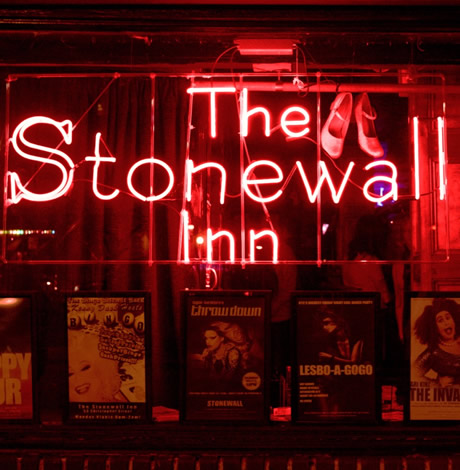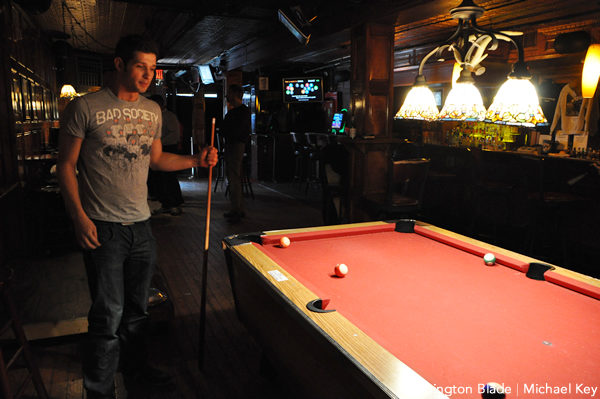Arts & Entertainment
Stonewall Inn’s owners look back while moving forward
LGBTQ landmark continues to evolve 50 years later


Open the front door to the Stonewall Inn today and you’ll find LGBTQ people from every walk of life. Locals and tourists alike gather for reasons as diverse as they are. Some patrons want to see the world-famous Stonewall Inn; others pop in for a cocktail and the rest simply want to hang out in a gay bar.
Among the crowd, you may even spot a famous face. Taylor Swift recently performed at Stonewall Inn; Joe Biden and his wife Jill Biden came by to celebrate the 50th anniversary of the Stonewall riots; and Madonna surprised fans with a New Year’s Eve performance at the historic bar in 2019.
Co-owners Kurt Kelly and Stacy Lentz gave birth to this modern-day Stonewall Inn when they purchased it in 2006.
Kelly, who is gay, felt that the Stonewall Inn had lost its connection with the LGBTQ community. He and a group of investors decided to purchase the property and brought investor Lentz, a lesbian community activist, on board as co-owner.
It was the first bar Kelly and Lentz had ever owned but they were ready to return the Stonewall Inn to its LGBTQ roots.
The original Stonewall Inn was a Mafia-owned bar located on 51–53 Christopher Street in the Greenwich Village neighborhood of New York City.
“The Mafia bought up a lot of the gay bars because they saw money involved in there. They saw money in those spaces because gay people would go there and spend a lot of money,” Kelly says.
Police raids were common for gay bars during that time and one such routine raid would make history on June 28, 1969 when bar patrons resisted arrest. The Stonewall Riots sparked a movement one year later when the first-ever Pride march was organized to commemorate the event. The march route stretched from the Stonewall Inn to Central Park.
Shortly after the riots, the Stonewall Inn shut down. Over the years, it was converted into a bagel shop, a deli and a shoe store before reopening as a bar at 51 Christopher Street from 1987 before shuttering in 1989. The 53 Christopher Street location reopened as a bar in 1990 as New Jimmy’s but the name was changed to Stonewall a year later.
Kelly, Lentz and their group of investors purchased the space at 53 Christopher Street making the new Stonewall Inn half the size of the original bar.
Today, the Stonewall Inn is recognized as the catalyst for the modern LGBTQ rights movement. In 2016, President Barack Obama designated the Stonewall National Monument, which includes Stonewall Inn and Christopher Street Park, located across the street from the bar. The Stonewall National Monument became the first national monument marking an LGBTQ designated site.
“I think it was incredible for the entire community, not just the owners of the bar, to have that recognized as telling us the fabric of American LGBTQ history is really important. The Parks Department and the national monument really can do that. We were super, super excited and it was an incredible moment for our entire community,” Lentz says. “It’s just extremely important for the LGBTQ community to have Stonewall, the birthplace, recognized as a national monument. Now it’s as famous as the Statue of Liberty or the Grand Canyon.”
The Stonewall Inn has also become known for its LGBTQ advocacy in recent years.
In 2013, Lentz helped organize 80 non-profits for a rally outside of the Stonewall Inn in support of marriage rights.
After the 2016 Pulse nightclub massacre, the outside of the Stonewall Inn became a memorial for the victims. The outside of the bar has also been the site of protests against the Trump administration.
Lentz decided to make Stonewall’s advocacy work more official in 2017.
She spearheaded the Stonewall Inn Gives Back Initiative, a non-profit organization working toward LGBTQ equality in the United States.
“We wanted to focus on places all over the country where equality has been slow to arrive. So a lot of that emphasis is on the 28 states where you can still be fired for being LGBTQ. They like to say you can get married on Friday and fired on a Monday. Legally, they don’t have the same options that we have and those places also have that daily stigma because of the prejudice of the communities around them,” Lentz says.
As World Pride draws near, Kelly and Lentz say they’re prepping for the momentous occasion.
“We’re planning to keep the doors open. We’re the epicenter. We’re at ground zero. We just have to make sure all the beer is there and the liquor is there for everyone to enjoy,” Kelly says.

The 50th anniversary of the Stonewall Riots has drawn more attention to the iconic bar and Kelly and Lentz hope that people will remember just how instrumental the Stonewall Inn was to the LGBTQ rights movement.
“That’s where Pride began and that’s where Pride lives,” Kelly says.
For Lentz, it’s also a conversation that needs to keep going.
“What happened there in 1969, the brave men and women that started that fight, is not over. We have to honor that and all continue to vow to work and keep going until we have full equality and that’s what we all have to do together,” Lentz says.
For more information on the Stonewall Inn Gives Back Initiative, visit stonewallinitiative.org.
Bars & Parties
Mixtape Sapphics hosts holiday party on Dec. 13
‘Sugar & Spice’ night planned for Saturday

Mixtape Sapphics will host “Sapphic Sugar & Spice: A Naughty-Nice Mixtape Holiday Party” on Saturday, Dec. 13 at 4 p.m. at Amsterdam Lounge.
This is a festive, grown holiday party for queer women and sapphics 35 and older at Revolt’s Christmas pop-up. There will be music, joy, and an optional White Elephant.
This is Mixtape Sapphics’ first-ever holiday party — a cozy, flirty, intentionally grounded night created just for queer women and sapphics 35+ who want real connection, festive joy, and a warm place to land at the end of the year.
Tickets start at $13.26 and can be purchased on Eventbrite.

Friday, December 12
“Center Aging Friday Tea Time” will be at 12 p.m. in person at the DC Center for the LGBT Community’s new location at 1827 Wiltberger St., N.W. To RSVP, visit the DC Center’s website or email [email protected].
Go Gay DC will host “LGBTQ+ Community Happy Hour” at 7 p.m. at Freddie’s Beach Bar and Restaurant. This event is ideal for making new friends, professional networking, idea-sharing, and community building. This event is free and more details are available on Eventbrite.
Women in Their Twenties and Thirties will be at 8 p.m. on Zoom. This is a social discussion group for queer women in the Washington, D.C. area. For more details, go to Facebook.
Saturday, December 13
Go Gay DC will host “LGBTQ+ Community Brunch” at 12 p.m. at Freddie’s Beach Bar & Restaurant. This fun weekly event brings the DMV area LGBTQ+ community, including allies, together for delicious food and conversation. Attendance is free and more details are available on Eventbrite.
The DC Center for the LGBT Community will host “Sunday Supper on Saturday” at 2 p.m. D.C.’s queer community will gather for good food, laughter, and community. For more information, email [email protected].
Sunday, December 14
SADBrunch will host “HokiSlay Drag Brunch” at 12 p.m. at Throw Social. This festive affair brings fierce performances, over-the-top holiday looks, and more sparkle than a tinsel explosion. Expect powerhouse lip-syncs, laughter, and cheer hotter than your spiked cocoa. Cake Pop will host the event. Tickets cost $28.52 and are available on Eventbrite.
Monday, December 15
“Center Aging: Monday Coffee Klatch” will be at 10 a.m. on Zoom. This is a social hour for older LGBTQ+ adults. Guests are encouraged to bring a beverage of choice. For more information, contact Adam ([email protected]).
Genderqueer DC will be at 7 p.m. on Zoom. This is a support group for people who identify outside of the gender binary, whether you’re bigender, agender, genderfluid, or just know that you’re not 100% cis. For more details, visit genderqueerdc.org or Facebook.
Tuesday, December 16
Center Bi+ Roundtable will be at 7 p.m. on Zoom. This is an opportunity for people to gather and discuss issues related to bisexuality or as Bi individuals in a private setting. Visit Facebook or Meetup for more information.
The DC Center for the LGBT Community will host “Self-Defense Class with Avi Rome” at 12:30 p.m. Rome is a proud member of the LGBTQ community and a full-time martial arts instructor with 25 years of teaching experience. He holds a Fifth Degree Black Belt in Jhoon Rhee Tae Kwon Do and is the director of the studio’s Adaptive Tae Kwon Do program for students with special needs. He has also run numerous self-defense workshops for various groups and situations. For more details, visit the center’s website.
Wednesday, December 17
Job Club will be at 6 p.m. on Zoom upon request. This is a weekly job support program to help job entrants and seekers, including the long-term unemployed, improve self-confidence, motivation, resilience and productivity for effective job searches and networking — allowing participants to move away from being merely “applicants” toward being “candidates.” For more information, email [email protected] or visit thedccenter.org/careers.
Asexual and Aromantic Group will be at 7 p.m. on Zoom. This is a space where people who are questioning this aspect of their identity or those who identify as asexual and/or aromantic can come together, share stories and experiences, and discuss various topics. For more details, email [email protected].
Thursday, December 18
The DC Center’s Fresh Produce Program will be held all day at the DC Center for the LGBT Community. People will be informed on Wednesday at 5 p.m. if they are picked to receive a produce box. No proof of residency or income is required. For more information, email [email protected] or call 202-682-2245.
Virtual Yoga Class will be at 7 p.m. on Zoom. This free weekly class is a combination of yoga, breath work and meditation that allows LGBTQ+ community members to continue their healing journey with somatic and mindfulness practices. For more details, visit the DC Center’s website.
Egypt
Iran, Egypt object to playing in Seattle World Cup ‘Pride Match’
Game to take place on June 26

Iran and Egypt have objected to playing in a “Pride Match” that will take place in Seattle during the 2026 World Cup.
The Egyptian Football Association on Tuesday said it told FIFA Secretary General Mattias Grafström in a letter that “it categorically rejects holding any activities related to supporting (homosexuality) during the match between the Egyptian national team and Iran, scheduled to be held in Seattle, USA, on June 26, 2026, in the third round of the group stage of the 2026 World Cup.” Football Federation Islamic Republic of Iran President Mehdi Taj told ISNA, a semi-official Iranian news agency that both his country and Egypt “protested this issue.”
The 2026 World Cup will take place in the U.S., Canada, and Mexico. The draw took place at the Kennedy Center on Dec. 5.
Iran is among the handful of countries in which consensual same-sex sexual relations remain punishable by death.
The State Department’s 2023 human rights report notes that while Egyptian law “did not explicitly criminalize consensual same-sex sexual activity, authorities regularly arrested and prosecuted LGBTQI+ persons on charges including ‘debauchery,’ prostitution, and ‘violating family values.’” Egyptian authorities “also reportedly prosecuted LGBTQI+ individuals for ‘misuse of social media.’”
“This resulted in de facto criminalization of same-sex conduct and identity,” notes the report.
The 2024 human rights report the State Department released earlier this year did not include LGBTQ-specific references.
Soccer has ‘unique power to unite people across borders, cultures, and beliefs’
The June 26 match between Iran and Egypt coincides with Seattle Pride. The Washington Post reported the Seattle FIFA World Cup 2026 Local Organizing Committee decided to hold the “Pride Match” before last week’s draw.
“As the Local Organizing Committee, SeattleFWC26’s role is to prepare our city to host the matches and manage the city experience outside of Seattle Stadium,” said SeattleFWC26 Vice President of Communications Hana Tadesse in a statement the committee sent to the Washington Blade on Wednesday. “SeattleFWC26 is moving forward as planned with our community programming outside the stadium during Pride weekend and throughout the tournament, partnering with LGBTQ+ leaders, artists, and business owners to elevate existing Pride celebrations across Washington.”
“Football has a unique power to unite people across borders, cultures, and beliefs,” added Tadeese. “The Pacific Northwest is home to one of the nation’s largest Iranian-American communities, a thriving Egyptian diaspora, and rich communities representing all nations we’re hosting in Seattle. We’re committed to ensuring all residents and visitors experience the warmth, respect, and dignity that defines our region.”
The 2034 World Cup will take place in Saudi Arabia.
Consensual same-sex sexual relations remain punishable by death in the country. The 2022 World Cup took place in neighboring Qatar, despite concerns over the country’s anti-LGBTQ rights record.
-

 Congress1 day ago
Congress1 day agoEXCLUSIVE: George Santos speaks out on prison, Trump pardon, and more
-

 Health4 days ago
Health4 days agoThe harsh truth about HIV phobia in gay dating
-

 Arts & Entertainment5 days ago
Arts & Entertainment5 days agoCynthia Erivo, Eva Victor, and ‘Blue Moon’ bring queer representation to Golden Globe film nominations
-

 Spain3 days ago
Spain3 days agoVictory Institute honors transgender Spanish senator in D.C.



















